ARTICLE
ABSTRACT
Models, especially in the form of assumed relationships between study variables and auxiliary variables, have influenced survey sampling theory and practice over the last four decades. Some of the early debates between the design-based school and the model-based school are revisited. In their pure forms, they offer two fundamentally different outlooks and approaches to inference in sample surveys. Complete reconciliation and agreement cannot be expected. But the tendency today is that each of the two approaches recognizes and profits from important elements in the other. We see an often fruitful interaction, as discussed in this article.
REFERENCES
ALEXANDER, C.H. (1987). A class of methods for using person controls in household weighting. Survey Methodology, 13, 183-188.
BREWER, K.R.W. (1963). Ratio estimation and finite population: some results deductible from the assumption of an underlying stochastic process. Australian Journal of Statistics, 5, 93-105.
BREWER, K.R.W. (1995). Combining design-based and model-based inference. In Cox, B.G. et al. (editors), Business Survey Methods. New York: Wiley, 589-606.
BREWER, K.R.W. (1999). Design-based or prediction inference? Stratified random vs stratified balanced sampling. International Statistical Review, 67, 35-47.
BREWER, K.R.W. (2002) Combined Survey Sampling Inference.Weighing Basu’s Elephants. London: Arnold.
BREWER, K.R.W., HANIF, M. and TAM, S.M. (1988). How nearly can modelbased prediction and design-based estimation be reconciled? Journal of the American Statistical Association 83, 128-32.
CASSEL, C.M, SÄRNDAL, C.E. and WRETMAN, J.H. (1976) Some results on generalized difference estimation and generalized regression estimation for finite populations. Biometrika 63, 615-620.
COCHRAN, W.G. (1953, 1963, 1977). Sampling Techniques. New York: Wiley; 1st, 2nd, 3rd edition.
DEMING, W.E. (1943). Statistical Adjustment of Data. New York: Wiley.
DEVILLE, J.C. and SÄRNDAL, C.E. (1992). Calibration estimators in survey sampling. Journal of the American Statistical Association, 87, 376-382.
DEVILLE, J.C. and TILLÉ, Y. (2004). Efficient balanced sampling: The Cube Method. Biometrika, 91, 893-912.
FOREMAN, E.K. and BREWER, K.R.W. (1971). The efficient use of supplementary information in standard sampling procedures. Journal of the Royal Statistical Society, series B, 33, 391-400.
GEUNA, S. (2000). Appreciating the difference between design-based and model-based sampling strategies in quantitative morphology of the nervous system. The Journal of Comparative Neurology, 427, 333-339.
GREGOIRE, T.G. (1998). Design-based and model-based inference in survey sampling: appreciating the difference. Canadian Journal of Forest Research, 28, 1429-1447.
HANSEN, M.H., MADOW, W.G. and TEPPING, B.J. (1983). An evaluation of model-dependent an probability-sampling inferences in sample surveys (with discussion). Journal of the American Statistical Association, 78, 776-807.
KALTON, G. (1981). Models in the practice of survey sampling. Invited paper, 43rd session of the International Statistical Institute, Buenos Aires.
KALTON, G. (1983). Models in the practice of survey sampling. International Statistical Review, 51, 175-188.
KALTON, G. (2002). Models in the practice of survey sampling (revisited). Journal of Official Statistics, 18, 129-154.
KOTT, P.S. (2005). Randomization-assisted model-based survey sampling. Journal of Statistical Planning and Inference, 129, 263-277.
LITTLE, R.J. (2003). To model or not to model? Competing modes of inference for finite population sampling. University of Michigan, Department of Biostatistics, working paper 2003:4.
NEYMAN, J. (1934). On the two different aspects of the representative method: the method of stratified sampling and the method of purposive selection. Journal of the Royal Statistical Society, 97, 558-625.
ROYALL, R.M. (1970). On finite population sampling under certain linear regression models. Biometrika, 57, 377-387.
ROYALL, R.M. (1994). Discussion of Smith (1994). International Statistical Review, 62, 19-20.
SÄRNDAL, C.E. (1978). Design-based and model-based inference in survey sampling. Scandinavian Journal of Statistics, 5, 27-52.
SÄRNDAL, C.E., SWENSSON, B. and WRETMAN, J. (1989). The weighted residual technique for estimating the variance of the general regression estimator of the finite population total. Biometrika, 76, 527-537.
SÄRNDAL, C.E., SWENSSON, B. and WRETMAN, J. (1992). Model Assisted Survey Sampling. New York: Springer-Verlag.
SÄRNDAL, C.E. AND LUNDSTRÖM, S. (2005). Estimation in surveys with nonresponse. New York: Wiley.
SMITH, T.M.F. (1976a). The foundations of survey sampling: a review. Journal of the Royal Statistical Society A, 139, 183-204.
SMITH, T.M.F. (1976b). Discussion of Cassel, Särndal and Wretman (1976). Biometrika 63, 620.
SMITH, T.M.F. (1994). Sample surveys 1975-1990; An age of reconciliation? International Statistical Review, 62, 5 -19.
